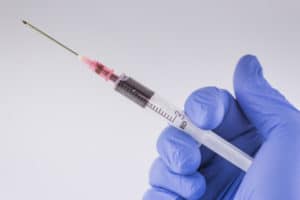Every unvaccinated patient that I have seen with a new shingles outbreak has told me emphatically they wish they had opted to get vaccinated. We are fortunate to now have a vaccine that can effectively reduce the risk of getting shingles. Zostavax was the first vaccine approved by the FDA in 2006 for patients older than 60, and in 2017 Shingrix was approved for patients older than 50.
Shingles, also called herpes zoster, is a painful viral infection caused by reactivation of the chickenpox virus that lays dormant in nerve roots after the initial chicken pox infection. People affected by the chickenpox virus in their past are all at risk for developing the painful shingles breakout that brings many patients into our office for treatment. The risk for developing shingles increases with age because of age-related weakened immunity, and 50% of people older than 85 will have shingles, and one of every 3 people who are unvaccinated will eventually develop shingles.
The lesions of shingles appear as red bumps, clusters of blisters, and red patches in a segmental distribution, usually only on one side of the body. While pain, sometimes prolonged even after the rash goes away, is a dreaded symptom, there are other more dangerous potential outcomes. For example, involvement of the facial areas around the eye can cause visual loss due to scarring of the eye.
Treating shingles early, within 72 hours of shingles onset, can reduce the pain and duration of the shingles lesions. Unfortunately, patients are often not aware that they have shingles within this short period of time. Even if treated early, patients are at risk of developing a prolonged pain syndrome called post-herpetic neuralgia.
Despite the fact that the shingles vaccine is effective, only 30% of patients older than 60 had received the vaccine by the end of 2015. As Dermatologists who see patients suffering with shingles, we want to educate our patients on the current vaccine recommendations and review the potential associated risks. Our goal is to increase the rates of vaccination.
Should I get Shingrix or Zostavax?
- Shingrix, the newest vaccine, is 90% effective in preventing shingles and post-herpetic neuralgia. Additionally, Shingrix does not lose effectiveness in people over age 70 like Zostavax does. Shingrix is a dead version of the virus, while Zostavax is a live virus. Although it requires 2 doses (2-6 months apart), I advise patients to maximize efficacy with the Shingrix vaccination.
Who should get the shingles vaccine?
- The CDC recommends healthy adults 50 or over get the Shingrix vaccine. Patients receiving immunosuppressive medications (such as biologics for psoriasis) are also potentially eligible to have Shringrix vaccination since it is not a live virus.
What side effects are associated with the Shingrix vaccine?
- Some patients have reported skin rash, joint pain, flu-like symptoms, headaches, and fatigue lasting 2-3 days. These reported side effects are minimal compared to the devastating symptoms people with a shingles outbreak may endure.
What if I already had the Zostivax vaccine? Should I get the Shingrix vaccine?
- Yes. The Shingrix vaccine is significantly more effective. It is also likely that the protective effect of the Shingrix vaccine will last longer than Zostivax. You should wait at least 2 months before receiving Shingrix after Zostivax.
Should I get the Shingrix vaccine if I already had shingles?
- Yes, you can still get shingles again, so vaccination is still advised.
What is the cost for the vaccines?
- The shingles vaccines are covered differently than influenza and pneumococcal vaccines. The cost to patients is variable depending on their insurance coverage, and co-pays are sometimes a barrier to getting the vaccine. Shingrix: $290 (includes the required 2 doses); Zostivax: $230 for single dose.
- Both drugs are covered under Medicare under Medicare Part D (co-pay price depends on tier within individual part D plan). The Affordable Care Act (ACA) requires that vaccines are treated as preventative care meaning cost is typically low for privately insured patients.
- Keep in mind that coverage may be better when the vaccine is administered at a pharmacy or at physician offices with a pharmacy onsite.


